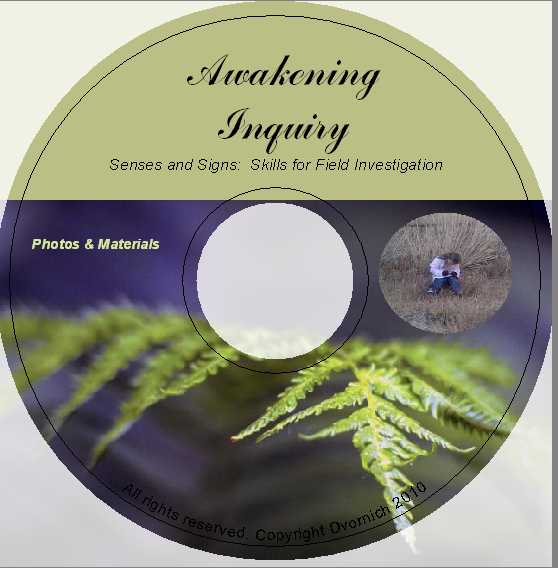

After years of taking students into the field on research projects, two common problems surfaced time and time again.
Students lacked "naturalist" skills that included how to observe; record observations in ways meaningful to them;
measure and estimate size and distance; use maps and orient themselves; and use their observations in an analytical way.
The other problem was what we called "sensory overload". Students taken into the field were in such a different environment,
they would forget what they learned in the classroom.
Awakening Inquiry was written as a core "how-to" book to overcome these challenges. It weaves three parallel approaches
to nature awareness into a step-by-step guide for the classroom and schoolyard in preparation for a field research project.
These approaches are derived from the NatureMapping Program, with its strength in science and technology;
Habits of Mind,
which focus on patterns of behavior that lead to lifelong inquiry and problem-solving; and the Coyote's Guide to
Connecting with Nature, which emphasizes development of a traditional kinship with nature.
Awakening Inquiry focuses on engaging a child's passions, so that the student, almost without being aware of it,
begins practicing the "Core Routine of Nature Connection" defined in Coyote's Guide. These Core Routines are learning habits
that help the brain to learn and remember what field biologists call "search images". Fun is a key component,
so Core Routines are incorporated into Awakening Inquiry units both as key activities and as tips embedded in the
lessons to reinforce techniques.
Awakening Inquiry is comprised of seven "how-to" units: Journal, Time/Date, Estimating Size and Numbers, Animal
and Plant Senses, Mapping, and Data Analysis. It includes grade-level expectations and assessments. Lessons in the
units are interspersed with Core Routines and begin with a game that prepares the students for the lessons.
All referenced materials are on the accompanying CD.
Awakening Inquiry is designed for homeschoolers to meet their science, math, reading and writing requirements;
pre-service teachers to build their skills before teaching them; informal educators to incorporate into their
existing programs; and formal educators to integrate across grade levels. The accompanying CD has all of the photos and
graphics needed to complete the lessons. Where else would you find pictures of owls, ant mounds or skunk tracks?
Authors
For more than 25 years, Karen Dvornich has worked in the fields of information technology and conservation biology.
In 1991, she became the Washington Gap Analysis Project Assistant for the Washington Cooperative Fish and Wildlife Research
Unit at the University of Washington, tasked to collect historic and current data on the wildlife in Washington State.
In 1992, Karen began asking retired natural resource professionals and Audubon members to report their wildlife observations,
because there was little current data for most species.
From 1982 to 2002, Karen also served as a docent at Woodland Park Zoo. Teachers began asking for help to
incorporate environmental education into their curriculum in 1992, and Karen realized that schools would be great
long-term wildlife monitoring sites, where students would become involved in outdoor field research. Together with
Margaret Tudor, Washington Department of Fish and Wildlife’s Project WILD coordinator, Karen wrote data-collection
protocols, designed workshops for teachers, and began the NatureMapping Program to encourage K–12 students
to become citizen scientists.
In 2001, Karen met renowned naturalist Jon Young, and began a partnership with the Wilderness Awareness School to
successfully link Core Routines and experiences mentoring students in awareness and connection with nature with public
school expectations by grade-level. Awakening Inquiry is the culmination of documenting this work and making it available
to teachers, mentors and parents worldwide.
Diane Petersen has taught first, second, fourth and fifth grades in the public school system of Washington
State for 25 years. She realized early on that science was a motivational subject for children, and that reading and
writing could be taught through the sciences. In 1987, she and her teaching partner, Cathi Nelson, launched a study of
the Douglas Creek watershed that continues today. Students in grades 4–6 explore the geology, plants, water quality and
animals of the watershed. The objectives are for students to collect data, learn the science, and develop an
understanding, appreciation, and love of their community.
In 1992, Diane decided to incorporate NatureMapping into their science program. This led to the development
of the Adopt-a-Farmer project in 1999, in which elementary school students teamed with local farmers to collect data on
Short-horned lizards in farm fields. Using the Adopt-a-Farmer project as a model, Diane and Karen Dvornich developed the
“Literate About Biodiversity” project in 2007,
in which each grade level studies and collects data on a different
taxonomic groups (such as spiders, butterflies, birds, insects and mammals).
Diane always tries to find new ways to excite her students. After she participated in a Coyote Mentoring
workshop at Wilderness Awareness School, she began working to fit its philosophies of outdoor awareness and
student mentoring into the public school system by testing the lessons developed in this book.
Ken Clarkson is the Director of the Nature Awareness Department at the Riekes Center for Human Enhancement.
He is a former US Fish and Wildlife Service refuge biologist who studied endangered species in Hawaii. He also
has more than 14 years of experience as an environmental educator. Karen Dvornich and Ken Clarkson met in 2001
at a gathering of outdoor nature awareness schools; the two have been collaborating ever since.
Ken brings his knowledge of nature awareness into classrooms, enticing teachers to begin
NatureMapping in outdoor areas in the vicinity of their schools.
Spiral bound
165 pages
CD included
View Table of Contents
Published by NatureMapping Foundation: www.naturemappingfoundation.org
Order online
Also available to purchase through
Acorn Naturalists
or Wilderness Awareness School
For checks or Purchase orders

